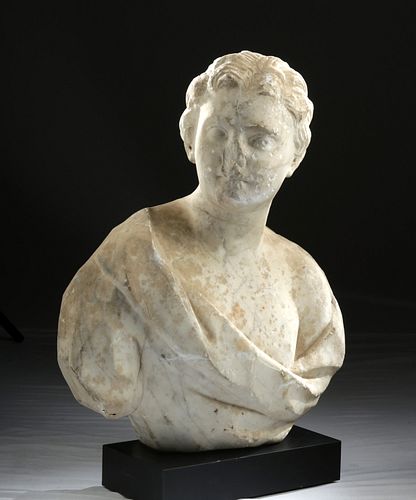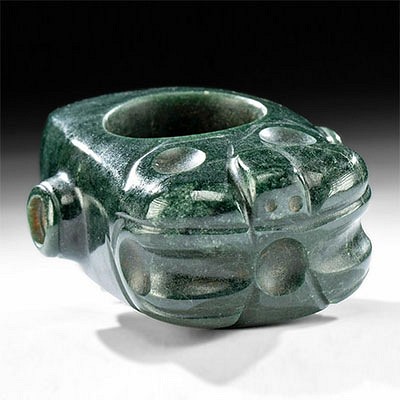Beautiful 17th C. Italian Baroque Marble Bust Clytie
Lot 29b
About Seller
Artemis Fine Arts
686 S Taylor Ave, Ste 106
Louisville, CO 80027
United States
Selling antiquities, ancient and ethnographic art online since 1993, Artemis Gallery specializes in Classical Antiquities (Egyptian, Greek, Roman, Near Eastern), Asian, Pre-Columbian, African / Tribal / Oceanographic art. Our extensive inventory includes pottery, stone, metal, wood, glass and textil...Read more
Estimate:
$6,000 - $9,000
Absentee vs Live bid
Two ways to bid:
- Leave a max absentee bid and the platform will bid on your behalf up to your maximum bid during the live auction.
- Bid live during the auction and your bids will be submitted real-time to the auctioneer.
Bid Increments
| Price | Bid Increment |
|---|---|
| $0 | $25 |
| $300 | $50 |
| $1,000 | $100 |
| $2,000 | $250 |
| $5,000 | $500 |
| $10,000 | $1,000 |
| $20,000 | $2,500 |
| $50,000 | $5,000 |
| $100,000 | $10,000 |
| $200,000 | $20,000 |
About Auction
By Artemis Fine Arts
Sep 10, 2020
Set Reminder
2020-09-10 10:00:00
2020-09-10 10:00:00
America/New_York
Bidsquare
Bidsquare : Antiquities | Asian | Ethnographic Art
https://www.bidsquare.com/auctions/artemis-gallery/antiquities-asian-ethnographic-art-5546
Featuring classical antiquities, ancient and ethnographic art from cultures encompassing the globe. Egyptian, Greek, Roman, Etruscan, Near Eastern, Asian, Pre-Columbian, Native American, African / Tribal, Oceanic, Spanish Colonial, Russian, Fossils, Fine Art, more! Artemis Fine Arts info@artemisgallery.com
Featuring classical antiquities, ancient and ethnographic art from cultures encompassing the globe. Egyptian, Greek, Roman, Etruscan, Near Eastern, Asian, Pre-Columbian, Native American, African / Tribal, Oceanic, Spanish Colonial, Russian, Fossils, Fine Art, more! Artemis Fine Arts info@artemisgallery.com
- Lot Description
Europe, Italy, Baroque period, ca. 17th century CE. A large marble bust of a female figure draped around the shoulders in an assymetric fashion so as to seductively reveal more of her left shoulder and chest. Perhaps this bust depicts Clytie (also Clytia), a lovely water nymph famous for her unrequited love of Helios, the god of the sun. Depicted in a sensuous state, as if she is about to disrobe, we see a mournful Clytie, still beautiful despite her shameful attempts to win Helios back from his new love Leucothoe (see more on this below). Her visage is comprised of large doe-shaped eyes with generous lids and incised pupils, elegantly arched brows above, delicate facial contours, and traces of her dainty nose and full lips, all framed by finely delineated thick, wavy locks. Size: 23.5" W x 29.375" H (59.7 cm x 74.6 cm); 32.5" H (82.6 cm) on included custom stand.
The story of Clytie and Helios is colorful to say the least. Helios deserted Clytie for Leucothoe. Driven to win Helios back, Clytie told Leucothoe's father Orchamus about the affair, and Orchamus had Leucothoe put to death. Unfortunately Clytie's attempts to win Helios back only angered him. Resigned, she removed her clothing, denied herself food and drink, and lay naked on the rocks for nine days, staring at the Helios - the sun - to demonstrate her mournful state.
Please note: The suggestion of dynamic movement as well as the emotional aspect of this piece aligns with the Baroque period. This said, an outside expert has suggested that it may in fact be a provincial Roman work.
Provenance: private J.H. collection, Beaverton, Oregon, USA
All items legal to buy/sell under U.S. Statute covering cultural patrimony Code 2600, CHAPTER 14, and are guaranteed to be as described or your money back.
A Certificate of Authenticity will accompany all winning bids.
We ship worldwide to most countries and handle all shipping in-house for your convenience.
#149616Losses to nose, lips, chin, and high-pointed areas of the cheeks, coiffure, and drapery. Small areas of blue and black pigment on verso. Earthen/mineral deposits grace the surface as well.Condition
- Shipping Info
-
All shipping is handled in-house for your convenience. Your invoice from Artemis Gallery will include shipping calculation instructions. If in doubt, please inquire BEFORE bidding for estimated shipping costs for individual items.
-
- Buyer's Premium



 EUR
EUR CAD
CAD AUD
AUD GBP
GBP MXN
MXN HKD
HKD CNY
CNY MYR
MYR SEK
SEK SGD
SGD CHF
CHF THB
THB






